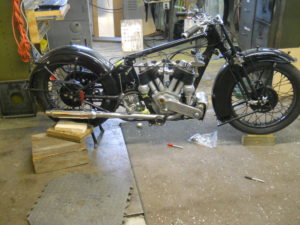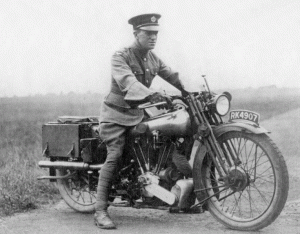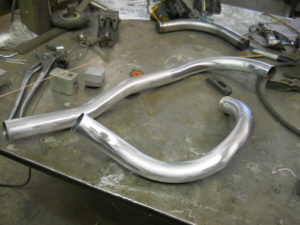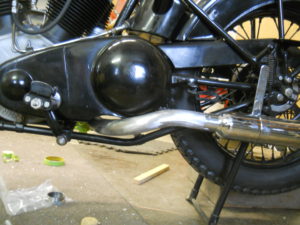1930’s Brough Superior
People sometimes go through what they call a “once in a lifetime experience”. Well recently I completed a project that was truly extraordinary, a “once in a lifetime” job. I was contacted by a gentlemen who restores vintage motorcycles and happens to be the only guy who restores Brough Superiors in the U.S.. I was asked if I would be interested in making a new exhaust system for a 1931 SS80, that just so happened to once belong to Steve McQueen. I took the job with enthusiasm, as this was a rare treat indeed.
Brough(Pronounced “Bruff”) Superiors were first introduced in the 1920’s and quickly became famous for their tight quality and superior performance. They were dubbed “The Rolls Royce of motorcycles” for their flashy symbolism and rather high price. The price was about $180, meanwhile the average person made about $3 weekly. Approximately 1,086 motorcycles were produced between 1922-1940 and all were built to custom fit each rider. Each motorcycle was assembled twice; once to ensure that all the parts fit properly, then it was dismantled and each part custom painted or plated, then re-assembled for final transport to be test driven and finally certified by George Brough himself. Quite a few of histories famous characters have owned a collection of these motorcycles, from Steve McQueen all the way to T.E. Lawrence (Lawrence of Arabia).
Oddly enough Lawrence died from injuries sustained while racing his Brough Superior named George VII. The 1931 Brough Superior SS80 I was working on, only 117 of these particular model were made in that year.
My task was no simple one for I had to fabricate, out of straight steel tubing, an intricate dual exhaust system that twist, turned and weaved through the frame and engine casing and ended at the mufflers on each side of the rear end.
Bending the tubes, in theory, was to be relatively simple. By welding a cap onto one end of the steel pipe then filling and packing the tube with sand and welding a second cap onto the end, then heating the pipe red hot, I was able to utilize an in house custom made tube bending machine to fabricate the bends and angles I desired.
Quite often the material I was using couldn’t be bent the way I needed without collapsing or splitting. I would make a partial bend on one tube, and another bend in a secondary tube then cut them down to size and weld the bends together, which the two would combine to equal the angle I needed. Rigorous hours of sanding by hand were needed after fabrication to get rid of weld lines and scratches and a final high count grid sanding to top it off and give it a shiny new look.





Comments
1930’s Brough Superior — No Comments
HTML tags allowed in your comment: <a href="" title=""> <abbr title=""> <acronym title=""> <b> <blockquote cite=""> <cite> <code> <del datetime=""> <em> <i> <q cite=""> <s> <strike> <strong>